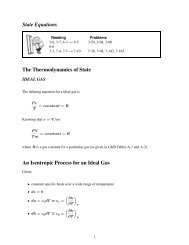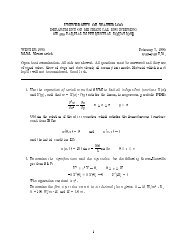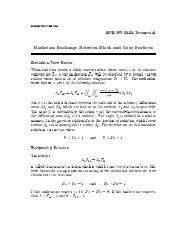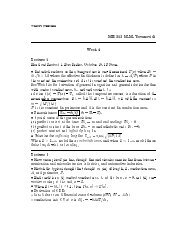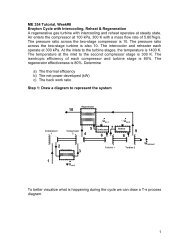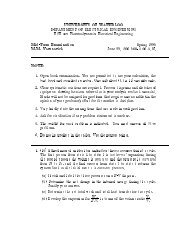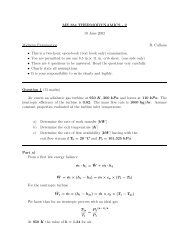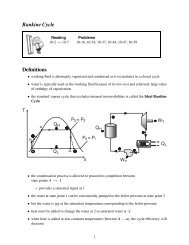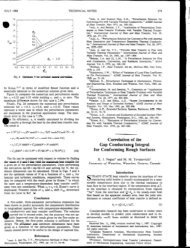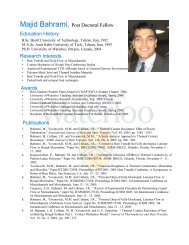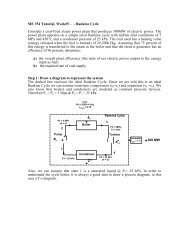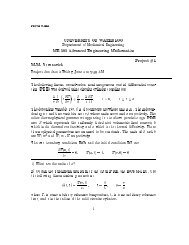Analytical Forced Convection Modeling of Plate Fin Heat Sinks
Analytical Forced Convection Modeling of Plate Fin Heat Sinks
Analytical Forced Convection Modeling of Plate Fin Heat Sinks
Create successful ePaper yourself
Turn your PDF publications into a flip-book with our unique Google optimized e-Paper software.
<strong>Analytical</strong> <strong>Forced</strong> <strong>Convection</strong> <strong>Modeling</strong> <strong>of</strong><strong>Plate</strong> <strong>Fin</strong> <strong>Heat</strong> <strong>Sinks</strong>P. Teertstra, M.M. Yovanovich and J.R. CulhamMicroelectronics <strong>Heat</strong> Transfer LaboratoryDepartment <strong>of</strong> Mechanical EngineeringUniversity <strong>of</strong>WaterlooWaterloo, Ontario, CanadaT.F. LemczykR-Theta Inc.Mississauga, Ontario, CanadaSEMI-THERM XVMarch 9, 1999Microelectronics <strong>Heat</strong> Transfer LaboratoryUniversity <strong>of</strong>Waterloo
Introduction: <strong>Plate</strong> <strong>Fin</strong> <strong>Heat</strong> <strong>Sinks</strong> <strong>Heat</strong> transfer enhancement for air cooled applications:{ increase eective surface area{ decrease thermal resistance{ reduce operating temperatures <strong>Plate</strong> n heat sinks most commonconguration <strong>Heat</strong> convected by ow through channels between nsSEMI-THERM XVMarch 9, 1999Microelectronics <strong>Heat</strong> Transfer LaboratoryUniversity <strong>of</strong>Waterloo
Introduction: <strong>Heat</strong> Sink Selection Numerous plate n heat sinks currently available <strong>Heat</strong> sink selection depends on many factors:{ performance{ dimensional constraints{ available airow{ cost Quick and accurate design tools are required:{ predict performance early in design{ perform trade o or \what if?" studies{ alternative to numerical simulation, experimentsSEMI-THERM XVMarch 9, 1999Microelectronics <strong>Heat</strong> Transfer LaboratoryUniversity <strong>of</strong>Waterloo
Objectives Develop analytical forced convection model for averageheat transfer rate for plate n heat sinks:{ laminar ow{ full range <strong>of</strong> developing and fully developed ow{ non-isothermal ns Perform experimental measurements for commercial heatsink and compare results with modelSEMI-THERM XVMarch 9, 1999Microelectronics <strong>Heat</strong> Transfer LaboratoryUniversity <strong>of</strong>Waterloo
Problem Denition - <strong>Plate</strong> <strong>Fin</strong> <strong>Heat</strong> Sink Array <strong>of</strong>N plates in perfect contact with baseplate Baseplate assumptions:{ isothermal{ adiabatic lower surface, edges Uniform velocity through channelswith no \leakage" out edges:{ shrouded heat sink{ with ow bypass model for un-shrouded heat sinks <strong>Heat</strong> sink modeled as N ; 1 parallel plate channelsSEMI-THERM XVMarch 9, 1999Microelectronics <strong>Heat</strong> Transfer LaboratoryUniversity <strong>of</strong>Waterloo
Problem Denition - Parallel <strong>Plate</strong> Channel Assume b H:{ 2D channel ow{ neglect baseplate, shroud eects Isothermal boundary conditions Reynolds number: Nusselt number:Nu b =Re b = UbQbkA(T w ; T a ) A =2LHSEMI-THERM XVMarch 9, 1999Microelectronics <strong>Heat</strong> Transfer LaboratoryUniversity <strong>of</strong>Waterloo
Model Development - Parallel <strong>Plate</strong> Channel <strong>Forced</strong> convection solutions available for 2 limiting cases:{ fully developed ow { developing ow Churchill and Usagi (1972) composite solution:i;1=nNu b =h(Nu fd ) ;n +(Nu dev ) ;nDeveloping Flowlog( Nu b)Fully-DevelopedComposite Solutionlog( Re b)SEMI-THERM XVMarch 9, 1999Microelectronics <strong>Heat</strong> Transfer LaboratoryUniversity <strong>of</strong>Waterloo
Model Development: Fully Developed Flow Asymptote Enthalpy balance assuming uid exit temperature = T wQ = _mc p (T w ; T a ) Fully developed ow asymptote:Nu b = 1 2 Re? b Prwhere channel Reynolds number dened as:Re ? b = Re b b LSEMI-THERM XVMarch 9, 1999Microelectronics <strong>Heat</strong> Transfer LaboratoryUniversity <strong>of</strong>Waterloo
Model Development - Developing Flow Asymptote Laminar forced convection solution in entrance <strong>of</strong> at,rectangular duct (Sparrow, 1955):Nu dev =0:664 p Re ? b Pr1=3 1+ 3:65p Re?bvalid for Pr 1.! 1=2 Approaches the at plate solution for large Re ? b :Nu L =0:664pReL Pr 1=3SEMI-THERM XVMarch 9, 1999Microelectronics <strong>Heat</strong> Transfer LaboratoryUniversity <strong>of</strong>Waterloo
Model Summary - Parallel <strong>Plate</strong> Channel26 Re?bNu b = 4Pr2;n+0! 11=2p@ 0:664 Re?b Pr1=3 1+ p 3:65 ARe?b;n375;1=nNu b10 110 0Numerical Data10 -1 Combination parameter fromFLOTHERM solutionsn =3 2.1 % RMS dierence betweenmodel and numerical dataModel10 -210 -1 10 0 10 1 10 2Re b*SEMI-THERM XVMarch 9, 1999Microelectronics <strong>Heat</strong> Transfer LaboratoryUniversity <strong>of</strong>Waterloo
Model Development - <strong>Heat</strong> Sink with Non-Isothermal <strong>Fin</strong>s High aspect ratio heat sinks:{ tall thin ns, small spacing{ increased surface area for convection{ eciency reduced <strong>Fin</strong> eciency : = Nu bNu iwhere Nu i \ideal" value from channel modelSEMI-THERM XVMarch 9, 1999Microelectronics <strong>Heat</strong> Transfer LaboratoryUniversity <strong>of</strong>Waterloo
Model Development - <strong>Heat</strong> Sink with Non-Isothermal <strong>Fin</strong>s Assume adiabatic condition at n tip:stanh (mH)hP = m = h = Nu i k fmHkA c b =tanhss2 Nu ik fk2 Nu ik fkHbHbHt H tL +1t tL +1SEMI-THERM XVMarch 9, 1999Microelectronics <strong>Heat</strong> Transfer LaboratoryUniversity <strong>of</strong>Waterloo
Model SummaryNu bQ = Nu b kA (T s ; T a )b= Nu i tanh26 Re?bNu i = 4Pr2ss2 Nu ik fk2 Nu ik fk;3+ NHbHbHt H tt L +1 tL +10! 1 31=2;3;1=3p@ 0:664 Re?b Pr1=3 1+ p 3:65 A 7Re? 5bSEMI-THERM XVMarch 9, 1999Microelectronics <strong>Heat</strong> Transfer LaboratoryUniversity <strong>of</strong>Waterloo
Experimental Apparatus High aspect ratio heat sink H=b 20 Back-to-back arrangement <strong>Heat</strong> sinks in Plexiglas shroud Approach velocity measured withhot wire anemometer Temperatures measured at 4locations on baseplate Radiation losses measured inseparate experimentSEMI-THERM XVMarch 9, 1999Microelectronics <strong>Heat</strong> Transfer LaboratoryUniversity <strong>of</strong>Waterloo
Experimental Procedure Measurements performed for the following cases:U aQ tot2 3 4 5 6 7 8 m=s100 200 300 400 500 W Re ? related to approach velocity U b a by continuity: Re ? = Ub2 Ao bbL = A 2U aL Nusselt number:Nu b =(Q tot =2) bkN(2 LH) ; T s ; T aSEMI-THERM XVMarch 9, 1999Microelectronics <strong>Heat</strong> Transfer LaboratoryUniversity <strong>of</strong>Waterloo
Model Validation543Nu b2Experimental DataChannel Model<strong>Heat</strong> Sink Model110 20 30 40 50Re b*SEMI-THERM XVMarch 9, 1999Microelectronics <strong>Heat</strong> Transfer LaboratoryUniversity <strong>of</strong>Waterloo
Summary and Conclusions <strong>Analytical</strong> forced convection model developed foraverage heat transfer rate for plate n heat sinks{ 2D channel model for shrouded high aspect ratioheat sinks, b H{ Temperature variation between ns and baseplate Model in excellent agreement with measured values:{ 2.1 %RMSdierence{ 6 % maximum dierenceSEMI-THERM XVMarch 9, 1999Microelectronics <strong>Heat</strong> Transfer LaboratoryUniversity <strong>of</strong>Waterloo
AcknowledgmentsThe authors gratefully acknowledge the support <strong>of</strong>: R-Theta Materials and Manufacturing OntarioSEMI-THERM XVMarch 9, 1999Microelectronics <strong>Heat</strong> Transfer LaboratoryUniversity <strong>of</strong>Waterloo



